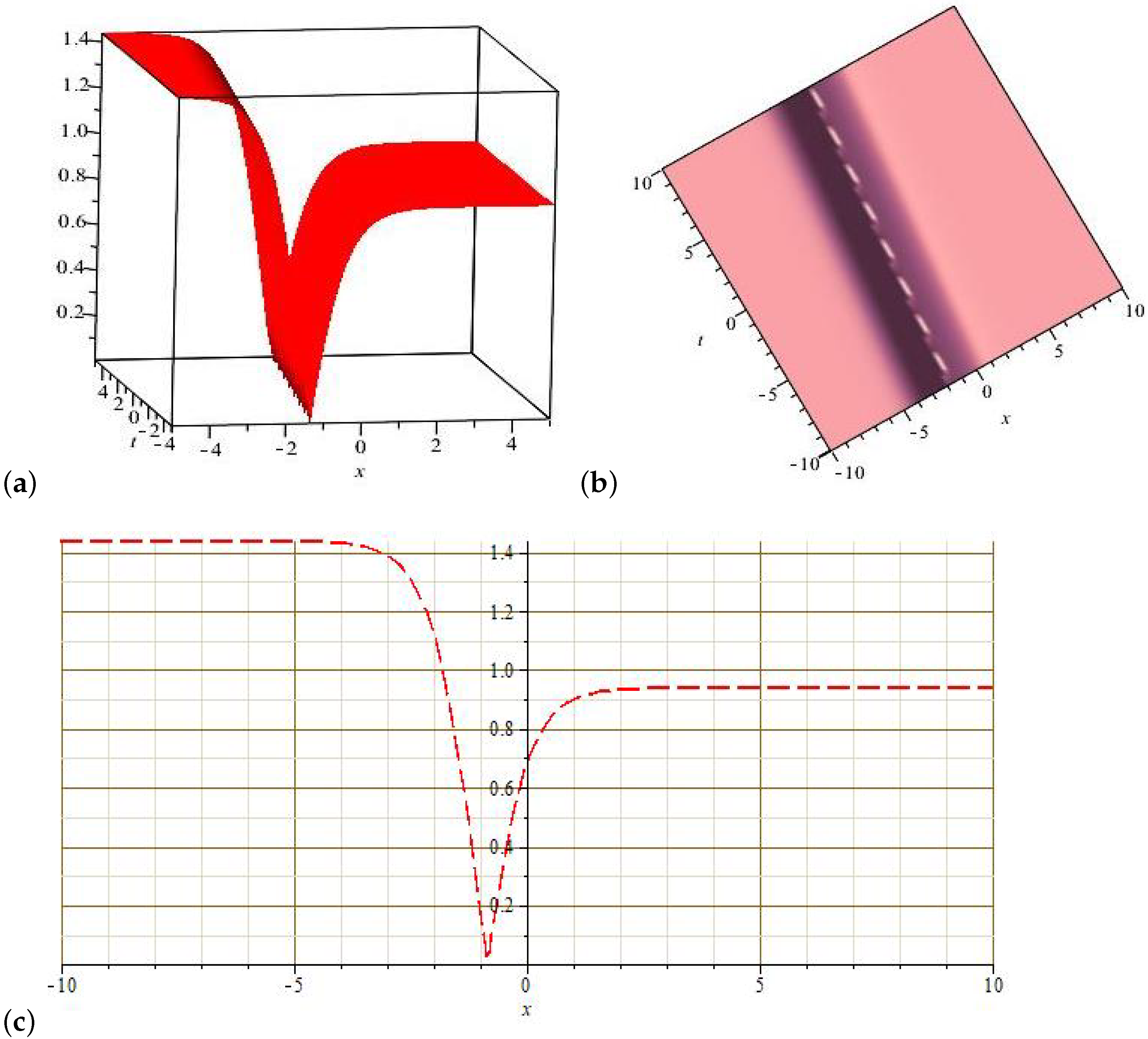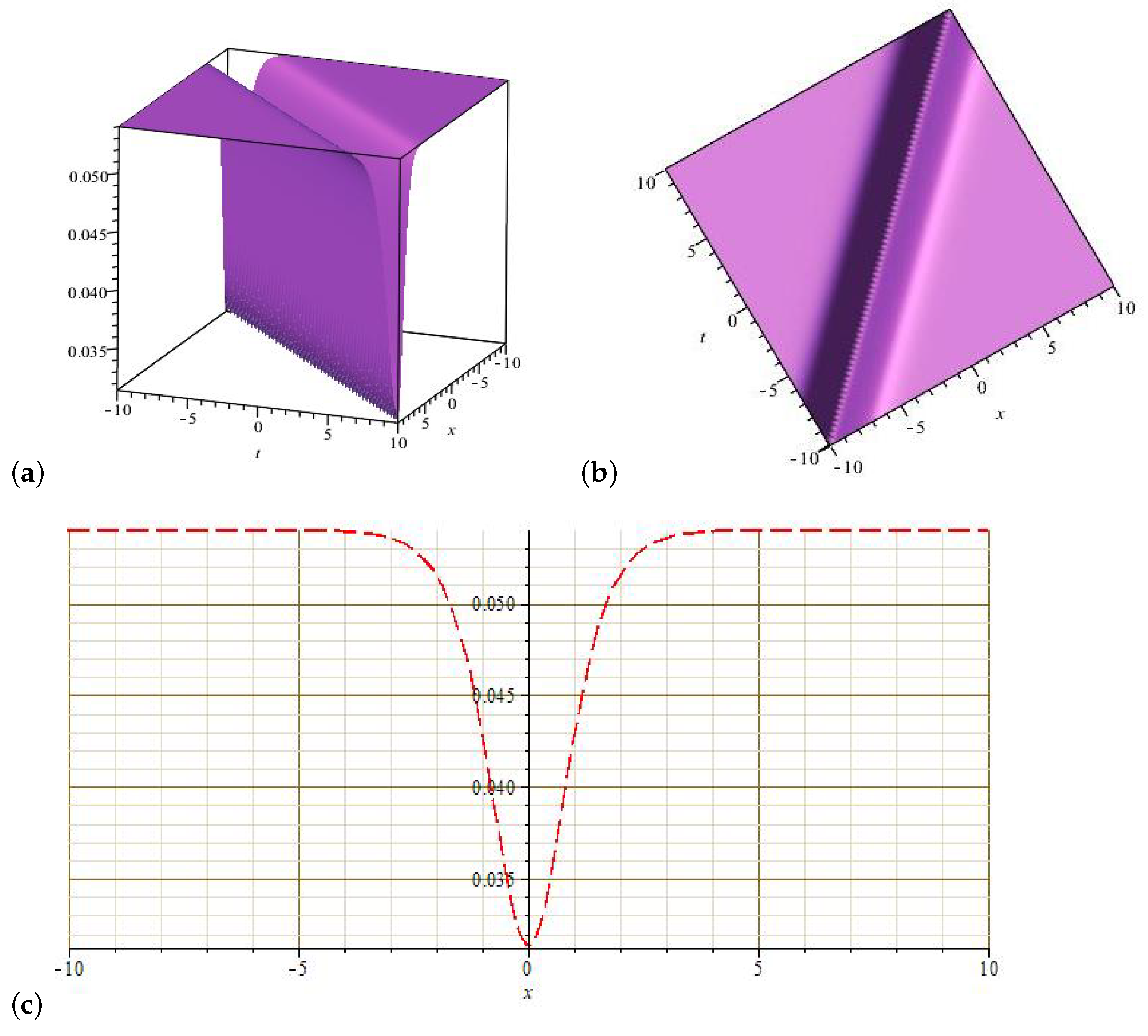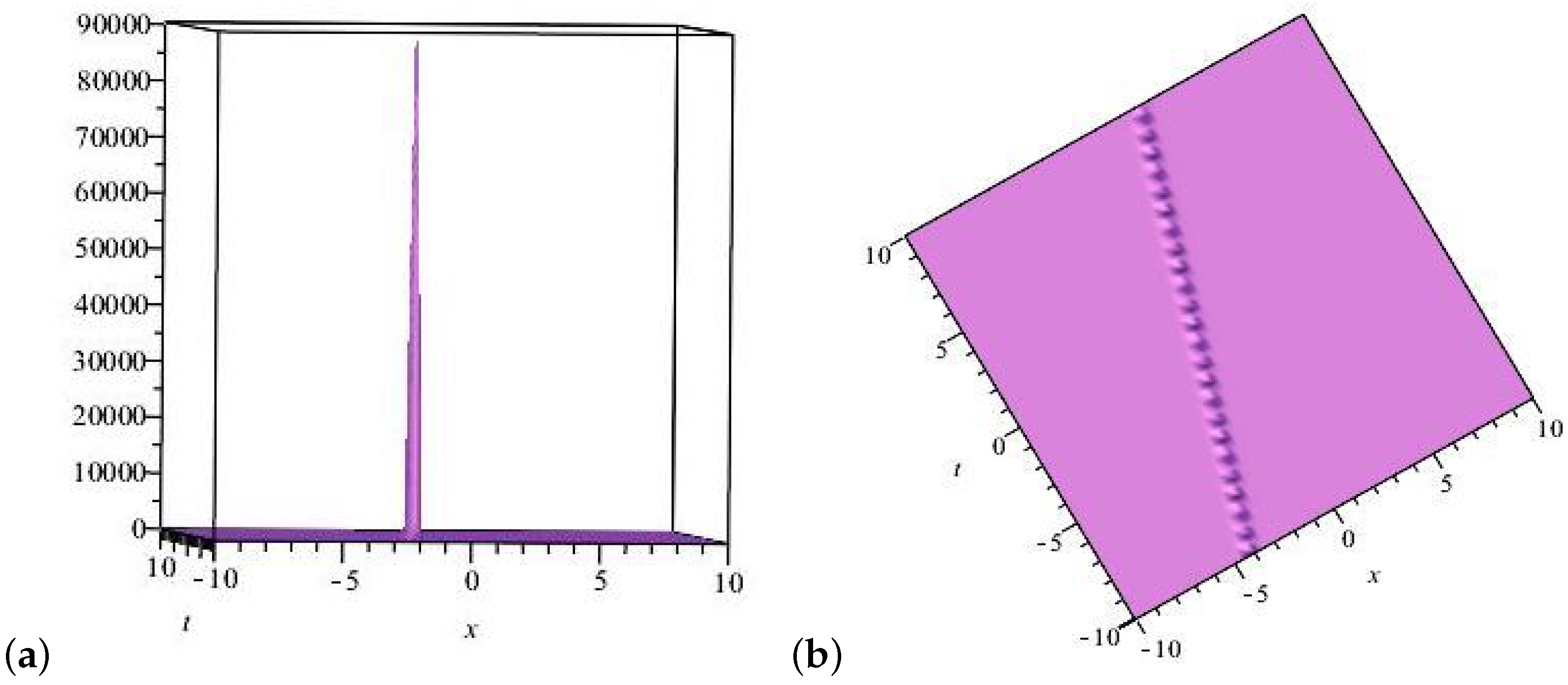Construction of Exact Solutions for Gilson–Pickering Model Using Two Different Approaches
Abstract
1. Introduction
2. Methodology of Extended Simple Equation Method
- Step 1:
- Let the PDE have the form
- Step 2:
- Consider the wave transformation:
- Step 3:
- Consider that Equation (7) has a solution of the form
- Step 4:
- Let satisfy the DE of the form
3. Methodology of Generalized Riccati Equation Mapping Method
- Step 3:
- Let the solution for Equation (7) have the form
- Type 1:
- When and or , the solutions of Equation (16) are given as
- Type 2:
- When and or , the solutions of Equation (16) are given as
- Type 3:
- When and , the solutions of Equation (16) are given as
- Type 4:
- When and , the only solution of Equation (16) is
4. Application of Extended Simple Equation Method
- Case 1:
- If
- Case 2:
- If , .
- Case 3:
- If , .
5. Application of Generalized Riccati Equation Mapping Method:
- Type 1:
- When and or , the solutions of Equation (18) are
- Type 2:
- When and or , the solutions of Equation (18) are
- Type 3:
- When and , the solutions of Equation (18) are
- Type 4:
- When and , the only solution of Equation (18) is
6. Results and Discussion
7. Conclusions
Author Contributions
Funding
Institutional Review Board Statement
Informed Consent Statement
Data Availability Statement
Acknowledgments
Conflicts of Interest
References
- Wang, M.; Tian, B.; Hu, C.C.; Liu, S.H. Generalized Darboux transformation, solitonic interactions and bound states for a coupled fourth-order nonlinear Schrodinger system in a birefringent optical fiber. Appl. Math. Lett. 2021, 119, 106936. [Google Scholar] [CrossRef]
- Shen, Y.; Tian, B. Bilinear auto-Bäcklund transformations and soliton solutions of a (3 + 1)-dimensional generalized nonlinear evolution equation for the shallow water waves. Appl. Math. Lett. 2021, 122, 107301. [Google Scholar] [CrossRef]
- Gao, X.T.; Tian, B.; Shen, Y.; Feng, C.H. Comment on: Shallow water in an open sea or a wide channel: Auto-and non-auto-Bäcklund transformations with solitons for a generalized (2 + 1)-dimensional dispersive long-wave system. Chaos Solitons Fractals 2021, 151, 111222. [Google Scholar] [CrossRef]
- Yang, D.Y.; Tian, B.; Qu, Q.X.; Zhang, C.R.; Chen, S.S.; Wei, C.C. Lax pair, conservation laws, Darboux transformation and localized waves of a variable-coefficient coupled Hirota system in an inhomogeneous optical fiber. Chaos Solitons Fractals 2021, 150, 110487. [Google Scholar] [CrossRef]
- Gao, X.Y.; Guo, Y.J.; Shan, W.R. Optical waves/modes in a multicomponent inhomogeneous optical fiber via a three-coupled variable-coefficient nonlinear Schrodinger system. Appl. Math. Lett. 2021, 120, 107161. [Google Scholar] [CrossRef]
- Gao, X.Y.; Guo, Y.J.; Shan, W.R. Beholding the shallow water waves near an ocean beach or in a lake via a Boussinesq-Burgers system. Chaos Solitons Fractals 2021, 147, 110875. [Google Scholar] [CrossRef]
- Cevikel, A.C.; Aksoy, E. Soliton solutions of nonlinear fractional differential equations with their applications in mathematical physics. Rev. Mex. Física 2021, 67, 422–428. [Google Scholar] [CrossRef]
- Cevikel, A.C. New exact solutions of the space-time fractional KdV-Burgers and nonlinear fractional foam Drainage equation. Therm. Sci. 2018, 22 (Suppl. 1), 15–24. [Google Scholar] [CrossRef]
- Aksoy, E.; Bekir, A.; Cevikel, A.C. Study on fractional differential equations with modified Riemann-Liouville derivative via Kudryashov method. Int. J. Nonlinear Sci. Numer. Simul. 2019, 20, 511–516. [Google Scholar] [CrossRef]
- Bekir, A.; Guner, O.; Cevikel, A. The exp-function method for some time-fractional differential equations. IEEE/CAA J. Autom. Sin. 2016, 4, 315–321. [Google Scholar] [CrossRef]
- Guner, O.; Bekir, A.; Cevikel, A.C. Dark soliton and periodic wave solutions of nonlinear evolution equations. Adv. Differ. Equ. 2013, 2013, 1–11. [Google Scholar] [CrossRef]
- Cevikel, A.C.; Bekir, A.; San, S.; Gucen, M.B. Construction of periodic and solitary wave solutions for the complex nonlinear evolution equations. J. Frankl. Inst. 2014, 351, 694–700. [Google Scholar] [CrossRef]
- Rehman, H.U.; Awan, A.U.; Tag-ElDin, E.M.; Alhazmi, S.E.; Yassen, M.F.; Haider, R. Extended hyperbolic function method for the (2 + 1)-dimensional nonlinear soliton equation. Res. Phys. 2022, 40, 105802. [Google Scholar] [CrossRef]
- Rehman, H.U.; Iqbal, I.; Subhi Aiadi, S.; Mlaiki, N.; Saleem, M.S. Soliton solutions of Klein–Fock–Gordon equation using Sardar subequation method. Mathematics 2022, 10, 3377. [Google Scholar] [CrossRef]
- Rehman, H.U.; Ullah, N.; Imran, M.A. Exact solutions of Kudryashov–Sinelshchikov equation using two analytical techniques. Eur. Phys. J. Plus 2021, 136, 1–13. [Google Scholar] [CrossRef]
- Rehman, H.U.; Awan, A.U.; Allahyani, S.A.; Tag-ElDin, E.M.; Binyamin, M.A.; Yasin, S. Exact solution of paraxial wave dynamical model with Kerr Media by using ϕ6 model expansion technique. Results Phys. 2022, 42, 105975. [Google Scholar] [CrossRef]
- Raza, N.; Arshed, S.; Sial, S. Optical solitons for coupled Fokas–Lenells equation in birefringence fibers. Mod. Phys. Lett. B 2019, 33, 1950317. [Google Scholar] [CrossRef]
- Wang, M.; Li, X.; Zhang, J. The (G′ G)–expansion method and travelling wave solutions of nonlinear evolution equations in mathematical physics. Phys. Lett. A 2008, 372, 417–423. [Google Scholar] [CrossRef]
- Xu, G.Q. Extended auxiliary equation method and its applications to three generalized NLS equations. Abstr. Appl. Anal. 2014, 2014, 541370. [Google Scholar] [CrossRef]
- Mahmud, F.; Samsuzzoha, M.; Akbar, M.A. The generalized Kudryashov method to obtain exact traveling wave solutions of the PHI–four equation and the Fisher equation. Res. Phys. 2017, 7, 4296–4302. [Google Scholar] [CrossRef]
- Wazwaz, A.M. The tanh method for traveling wave solutions of nonlinear equations. Appl. Math. Comput. 2004, 154, 713–723. [Google Scholar] [CrossRef]
- Seadawy, A.R.; Ali, A.; Zahed, H.; Baleanu, D. The Klein–Fock–Gordon and Tzitzeica dynamical equations with advanced analytical wave solutions. Results Phys. 2020, 19, 103565. [Google Scholar] [CrossRef]
- Lu, D.; Seadawy, A.; Arshad, M. Applications of extended simple equation method on unstable nonlinear Schrodinger equations. Optik 2017, 140, 136–144. [Google Scholar] [CrossRef]
- Zhu, S.D. The generalizing Riccati equation mapping method in nonlinear evolution equation: Application to (2 + 1)-dimensional Boiti–Leon–Pempinelle equation. Chaos Solitons Fractals 2008, 37, 1335–1342. [Google Scholar] [CrossRef]
- Zhao, Y.M. F–expansion method and its application for finding new exact solutions to the Kudryashov-Sinelshchikov equation. J. Appl. Math. 2013, 2013, 895760. [Google Scholar] [CrossRef]
- Ma, W.X.; Lee, J.H. A transformed rational function method and exact solutions to the (3+1)–dimensional Jimbo-Miwa equation. Chaos Solitons Fractals 2009, 42, 1356–1363. [Google Scholar] [CrossRef]
- Ma, W.X.; Fuchssteiner, B. Explicit and exact solutions to a Kolmogorov-Petrovskii-Piskunov equation. Int. J. Non-Linear Mech. 1996, 31, 329–338. [Google Scholar] [CrossRef]
- Kumar, S.; Mohan, B. A novel and efficient method for obtaining Hirota’s bilinear form for the nonlinear evolution equation in (n + 1) dimensions. Partial. Differ. Equ. Appl. Math. 2022, 5, 100274. [Google Scholar] [CrossRef]
- Ahmad, S.; Saifullah, S.; Khan, A.; Inc, M. New local and nonlocal soliton solutions of a nonlocal reverse space–time mKdV equation using improved Hirota bilinear method. Phys. Lett. A 2022, 450, 128393. [Google Scholar] [CrossRef]
- Ma, W.X. A polynomial conjecture connected with rogue waves in the KdV equation. Partial. Differ. Equ. Appl. Math. 2021, 3, 100023. [Google Scholar] [CrossRef]
- Zhao, T.; Wang, M.; Chu, Y. On the bounds of the perimeter of an ellipse. Acta Math. Sci. 2022, 42, 491–501. [Google Scholar] [CrossRef]
- Rezazadeh, H.; Jhangeer, A.; Tala-Tebue, E.; Hashemi, M.S.; Sharif, S.; Ahmad, H.; Yao, S.W. New wave surfaces and bifurcation of nonlinear periodic waves for Gilson–Pickering equation. Res. Phys. 2021, 24, 104192. [Google Scholar] [CrossRef]
- Bazighifan, O.; Ahmad, H.; Yao, S.W. New oscillation criteria for advanced differential equations of fourth order. Mathematics 2020, 8, 728. [Google Scholar] [CrossRef]
- Ghanbari, B.; Nisar, K.S.; Aldhaifallah, M. Abundant solitary wave solutions to an extended nonlinear Schrödinger’s equation with conformable derivative using an efficient integration method. Adv. Differ. Equ. 2020, 2020, 1–25. [Google Scholar] [CrossRef]
- Yokus, A.; Durur, H.; Ahmad, H.; Yao, S.W. Construction of different types analytic solutions for the Zhiber–Shabat equation. Mathematics 2020, 8, 908. [Google Scholar] [CrossRef]
- Yokus, A.; Durur, H.; Ahmad, H.; Thounthong, P.; Zhang, Y.F. Construction of exact traveling wave solutions of the Bogoyavlenskii equation by (G′/G, 1/G)-expansion and (1/G′)-expansion techniques. Res. Phys. 2020, 19, 103409. [Google Scholar] [CrossRef]
- Yokus, A.; Durur, H.; Ahmad, H. Hyperbolic type solutions for the couple Boiti–Leon–Pempinelli system. Facta Univ. Ser. Math. Inf. 2020, 35, 523–531. [Google Scholar] [CrossRef]
- Yokus, A.; Kaya, D. Comparison exact and numerical simulation of the traveling wave solution in nonlinear dynamics. Int. J. Mod. Phys. B 2020, 34, 2050282. [Google Scholar] [CrossRef]








Publisher’s Note: MDPI stays neutral with regard to jurisdictional claims in published maps and institutional affiliations. |
© 2022 by the authors. Licensee MDPI, Basel, Switzerland. This article is an open access article distributed under the terms and conditions of the Creative Commons Attribution (CC BY) license (https://creativecommons.org/licenses/by/4.0/).
Share and Cite
Rehman, H.U.; Awan, A.U.; Tag-ElDin, E.M.; Bashir, U.; Allahyani, S.A. Construction of Exact Solutions for Gilson–Pickering Model Using Two Different Approaches. Universe 2022, 8, 592. https://doi.org/10.3390/universe8110592
Rehman HU, Awan AU, Tag-ElDin EM, Bashir U, Allahyani SA. Construction of Exact Solutions for Gilson–Pickering Model Using Two Different Approaches. Universe. 2022; 8(11):592. https://doi.org/10.3390/universe8110592
Chicago/Turabian StyleRehman, Hamood Ur, Aziz Ullah Awan, ElSayed M. Tag-ElDin, Uzma Bashir, and Seham Ayesh Allahyani. 2022. "Construction of Exact Solutions for Gilson–Pickering Model Using Two Different Approaches" Universe 8, no. 11: 592. https://doi.org/10.3390/universe8110592
APA StyleRehman, H. U., Awan, A. U., Tag-ElDin, E. M., Bashir, U., & Allahyani, S. A. (2022). Construction of Exact Solutions for Gilson–Pickering Model Using Two Different Approaches. Universe, 8(11), 592. https://doi.org/10.3390/universe8110592




